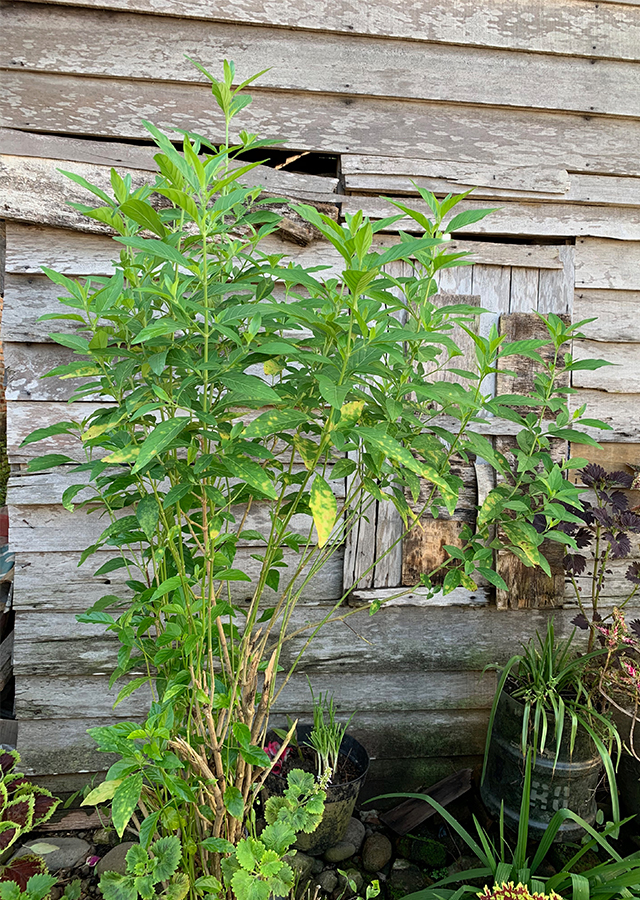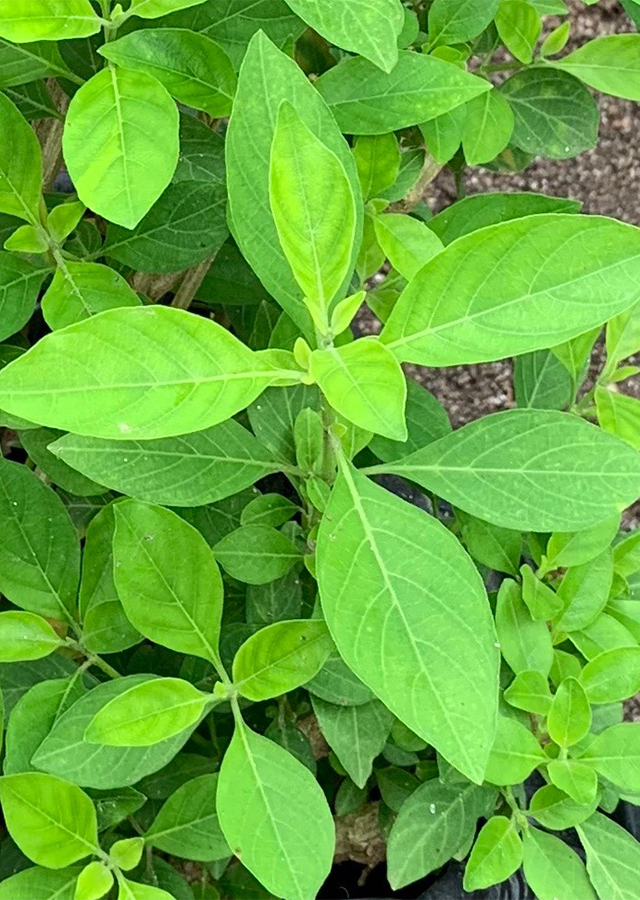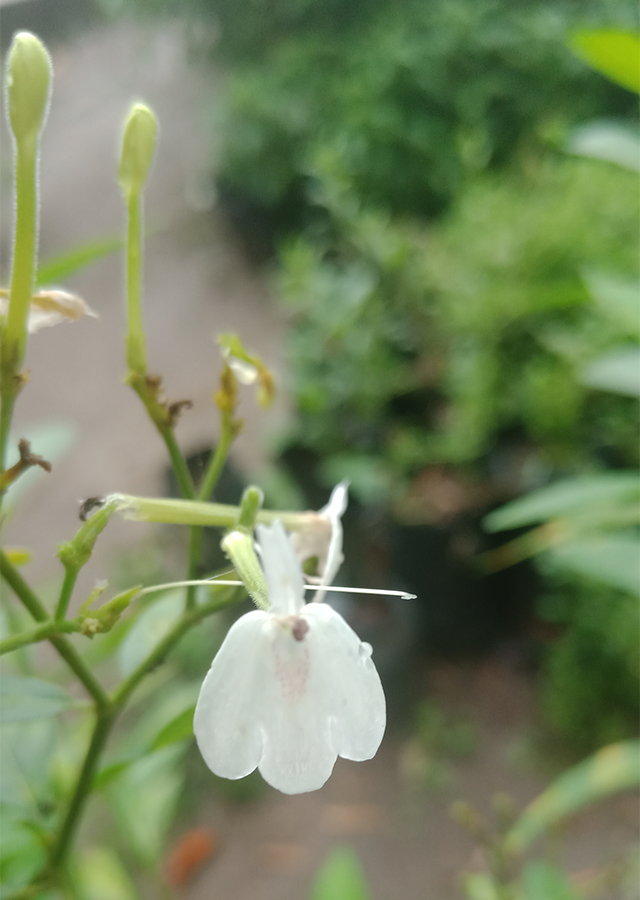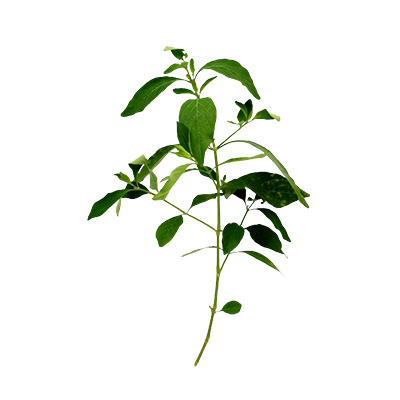Snake Jasmine
Rhinacanthus nasutus (L.) Kurz
Acanthaceae
Location in our garden
Principal



Synonym
Dianthera paniculata Lour.
Justicia dichotoma Rottler
Justicia gendarussa Macrae ex Nees
Habitus
Shrubs. An erect, much-branched shrub growing up to 2 m tall, occasionally to 3 m
Part Used
Leaves
Roots
Stem
Growing Requirements
Full Sunshine
Need Shade
Habitat
Rocky Areas
Shrublands
Grassland
Overview
Even native to India, Rhinacanthus nasutus is a herb that is widely distributed and known for its antioxidant properties in sub-continental parts of India and China as well as in various countries such as Thailand in Southeast Asia. It is widely known as Snake Jasmine because of the shape of its flowers and because the root has traditionally been used as an antidote to snake venom.
Vernacular Names
Parajito (Philippines), Anitia (Myanmar), Thong kan2 sang (Laos), Thong khan chang (Thailand), Bạch hạc (Vietnamese).
Agroecology
It is found up to the altitude of 750 m in thickets, hedges and waste areas. On humid, well-drained soils, it thrives best, but it is also found in much drier environments, such as rock crevices.
Morphology
- Roots - lateral root.
- Leaves - Opposite, simple, ovate to lanceolate or elliptical, 3-10 cm x 1-5 cm, acute to attenuate base, whole margin, acute apex, puberulent; 0.5-2 cm long petiole; absent stipules.
- Flowers - 5-6 mm long, corolla 2-lipped, tube narrowly cylindrical, green, upper lip with 2 teeth, 8-10 mm x 2-3 mm, white lower lip with 3 large lobes, white corolla 2-lipped, tube narrowly cylindrical, green, upper lip with 2 teeth, 8-10 mm x 2-3 mm, white lower lip with 3 large lobes, white with red markings at the base, inserted at the apex of the corolla tube, inserted at an unequal stage.
- Fruits - a clavate, loculicidal, puberulous capsule, 17-25 mm long, basal part sterile.
- Seeds - held up on well-developed hooks (retinacula), orbicular, flat, pubescent.
Cultivation
- Propagated by stem cuttings. During the rainy season, cuttings of about 10 cm, comprising 2-3 nodes, are planted under partial shade.
- Propagation by in vitro culture is another option.
Chemical Constituents
β-sitosterol, flavonoids, triterpenoids, saponins, polyphenols, tannins, phenols, lupeol, steroids, terpenoids, anthraquinones, lignans and naphthoquinone analogues.
Traditional Medicinal Uses
- The leaves are considered to be antidote, antihypertensive, anti-inflammatory, antipyretic and detoxicant.
- The treatment of such diseases such as cancer, liver disorders, skin diseases, peptic ulcers, helminthiasis, scurvy, inflammation and obesity, can have possible consequences.
- For the treatment of diseases such as eczema, pulmonary tuberculosis, herpes, hepatitis, diabetes, hypertension and other skin diseases, various parts of R.nasutus have been used in traditional medicine.
- They are prepared with sulphur and benzoin or vaseline in the Malayan Peninsular.
- In Thailand, alcohol, lemon and tamarind juice can be pounded into the leaves. On the contaminated skin, the resulting extract is added.
- In Vietnam, an infusion has a reputation in folk medicine for the treatment of hypertension.
- Stems and leaves are also used in China to treat ringworm infections, as well as in early tuberculosis stages. The leaf is used against snake venom when applied internally.
Part Used
Reference Sources
- Wongsatit Chuakul, Noppamas Soonthornchareonnon & Promjit Saralamp. (2016). Pl@nt Use. Rhinacanthus nasutus (PROSEA). https://uses.plantnet-project.org/en/Rhinacanthus_nasutus_(PROSEA). 15-08-2020.
- Fern, Ken. (2014). Useful Tropical Plants. Rhinacanthus nasutus. http://tropical.theferns.info/viewtropical.php?id=Rhinacanthus+nasutus. 15-08-2020.
- Bukke. Suman, P.S. Raghu, G. Sailaja, and R.K. Thyaga. (2011). The study on Morphological, Phytochemical and Pharmacological aspects of Rhinacanthus nasutus. (L) Kurz (A Review). https://pdfs.semanticscholar.org/7160/540efe364c7114aa0844fa1fb1734ed8d958.pdf. 15-08-2020.
- prosea. (No date). Plant Resources of the World. Rhinacanthus nasutus (L.). https://prota4u.org/prosea/view.aspx?id=407. 06-11-2020.



